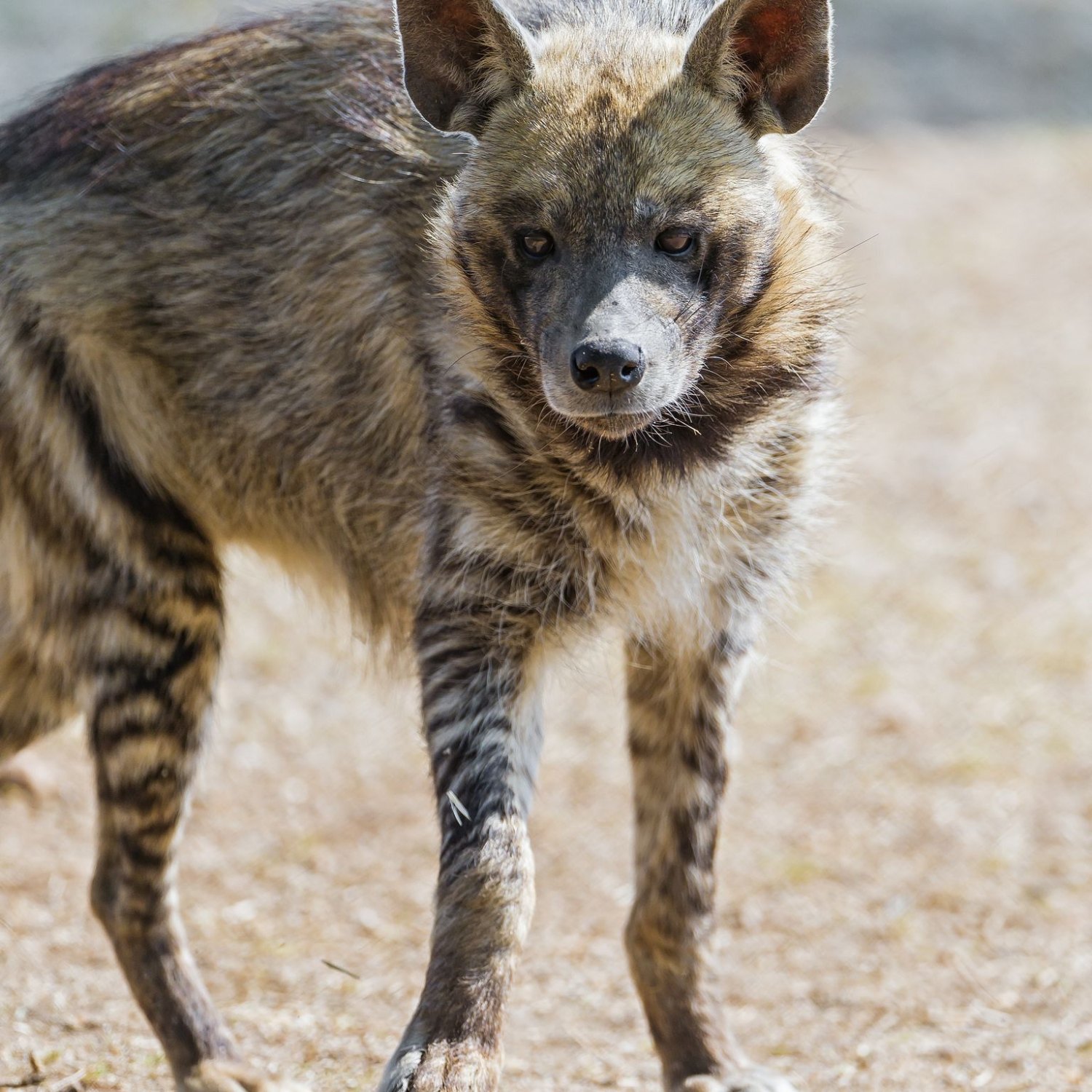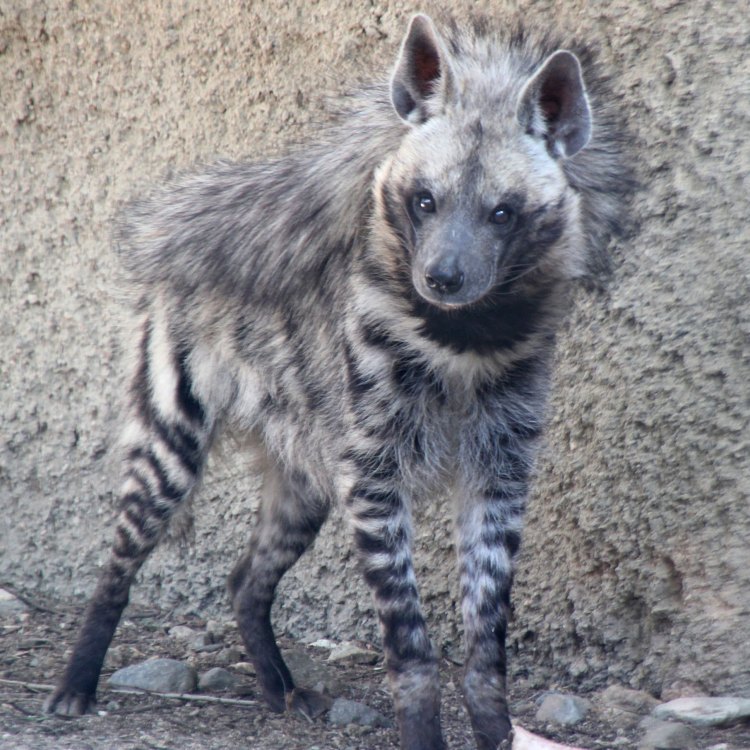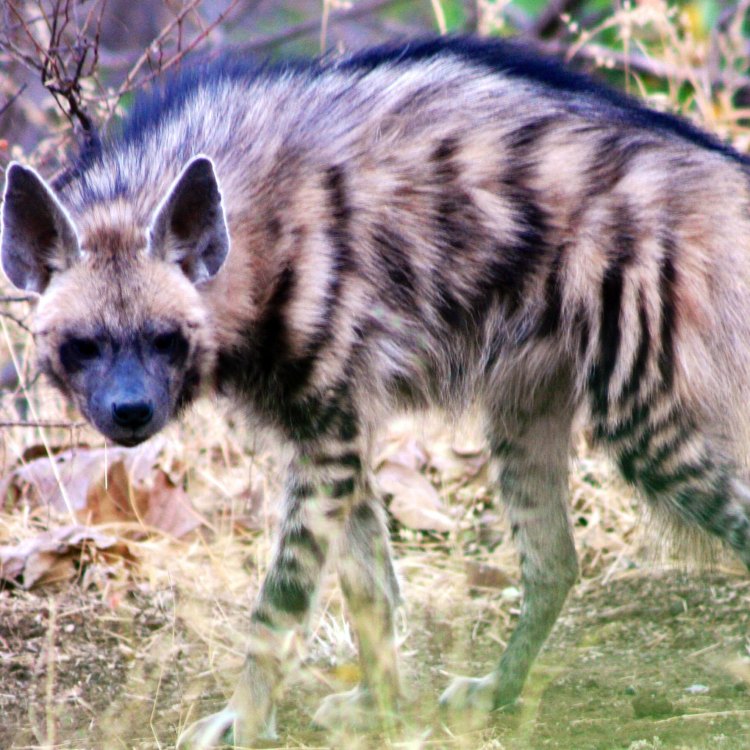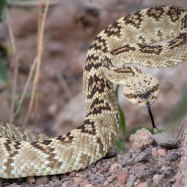
Striped Hyena
100 to 140 cm
Did you know? The Striped Hyena, found in a wide range from Africa to India, belongs to the Hyaenidae family. With a body length of 100 to 140 cm, it has a compact build and is categorized under Animals S. Despite its name, this hyena's stripes may not always be visible. #StripedHyena #Hyaenidae #WildlifeFacts
Animal Details Summary:
Common Name: Striped Hyena
Kingdom: Animalia
Habitat: Savannahs, deserts, forests, and mountains
The Fascinating World of the Striped Hyena
Have you ever heard of the Striped Hyena? This stunning creature may not be as well-known as other big cats or bears, but it is just as fascinating. From its unique physical features to its behavior, the Striped Hyena is a truly one-of-a-kind animal that deserves to be appreciated and understood. Join me as we embark on a journey into the world of this magnificent creature.A Closer Look at the Striped Hyena
Scientifically known as Hyaena hyaena, the Striped Hyena is also commonly referred to as the Striped Hyaena Striped Hyena. It belongs to the family Hyaenidae, which includes other hyena species such as the Spotted Hyena and the Brown Hyena. While the Striped Hyena may share some physical characteristics with its relatives, it stands out with its distinctive striped coat and smaller size.The Striped Hyena can be found in different areas across the globe, from Africa to the Middle East and Central Asia. It is a widespread species with no endangered status, but its numbers have been decreasing due to habitat loss and human-wildlife conflict.
Anatomy and Physical Appearance
The Striped Hyena has a striking appearance, with a medium-sized body and a compact build. Its length can range from 100 to 140 cm, or 3.3 to 4 feet, and it can weigh between 22 to 55 kg, or 48 to 121 lbs. The male hyenas are typically larger and heavier than females.One of the most notable physical features of the Striped Hyena is its distinctive coat Sea Slug. It has a yellowish-gray color with black stripes that run vertically down its body. These stripes give it a unique look and help it blend in with its surroundings. The stripes on the legs and neck may merge into transverse bands, while the belly is usually a lighter color.
The Striped Hyena also has strong and powerful jaws, with sharp pointed teeth that are adapted for both scavenging and hunting. Its front legs are slightly longer than its hind legs, making it easier for the hyena to run and maneuver in different terrains.
Habitat and Distribution
The Striped Hyena is a highly adaptable species, and it can be found in a variety of habitats, including savannahs, deserts, forests, and even mountains. Its wide distribution is a testament to its ability to thrive in different environments.As mentioned earlier, the Striped Hyena can be found in different countries, including Kenya, Tanzania, Iran, and India. It has a strong presence in sub-Saharan Africa and is also prevalent in the Middle East, particularly in Israel and Saudi Arabia.
Feeding Habits
The Striped Hyena is a skilled scavenger, and it plays an essential role in its ecosystem by cleaning up carcasses and preventing the spread of disease. They have a keen sense of smell and can locate a carcass from several kilometers away.But the Striped Hyena is not just a scavenger; it is also a skilled hunter. They have been known to take down prey such as antelopes, rodents, reptiles, and even domestic animals like sheep and goats.
As cunning hunters, Striped Hyenas often collaborate in groups to take down larger prey. They have also been observed using their strong jaws to break open bones and gain access to the nutritious marrow inside.
Behavior and Social Structure
The Striped Hyena is a primarily nocturnal animal, and it is most active at night. During the day, they will usually seek shelter in underground burrows or caves. They are not very vocal animals, but can make a variety of sounds, including howls, barks, and growls.While Striped Hyenas may occasionally roam alone, they are generally social animals, living in clans that can consist of up to 20 individuals. These groups are led by a dominant female and male and often include their offspring.
The hierarchy within a clan is maintained through vocalizations and physical displays, with dominant individuals having access to food and other resources. However, it is not uncommon for lower-ranking members to challenge dominant individuals and even take over their position in rare cases.
Strong Mothers and Protective Fathers
One of the most unique aspects of Striped Hyenas is their parenting dynamic. Unlike other mammals, where the mother plays the primary role in raising the offspring, Striped Hyenas have a more equal sharing of responsibilities between males and females.Striped Hyenas have a long gestation period of up to 110 days, and females usually give birth to two to four cubs at a time. Both parents play an active role in caring for the cubs, with the male assisting in the birth and taking an active role in rearing the young.
Male hyenas have also been observed sharing food with their families and aggressively defending their territory and young from predators. This unique and cooperative parenting style makes Striped Hyenas stand out even more in the animal kingdom.
The Myth and Misunderstanding Surrounding Hyenas
Unfortunately, the Striped Hyena, along with other hyena species, has faced a lot of negative stereotypes and misunderstanding over the years. They have often been portrayed as sneaky, dirty, and cowardly animals in popular culture, such as in "The Lion King" and "The Lion Guard."But in reality, Striped Hyenas are intelligent and resilient animals that play an important role in the ecosystem. Despite being the smallest of the hyena species, they can survive in a wide range of habitats and have complex social structures.
Furthermore, they have a crucial role in controlling the population of other animals and preventing the spread of disease. The Striped Hyena is an essential part of the natural balance in its habitat, and it is time for these amazing creatures to receive the love and respect they deserve.
In Conclusion
The Striped Hyena may not be as well-known as some other predators, but it is undoubtedly a fascinating and unique animal in its own right. Its distinctive stripes, strong social structures, and cooperative parenting style make it a standout in the animal kingdom.While they may face some challenges, such as habitat loss, the Striped Hyena is a resilient species with a vast distribution range. It is up to us to ensure their habitats are protected and to educate others about the essential role these creatures play in their ecosystems.
Next time you come across the Striped Hyena in a documentary or at a zoo, take a moment to appreciate its intelligence and strength. With more awareness and understanding, these amazing animals can continue to thrive in the wild for generations to come.

Striped Hyena
Animal Details Striped Hyena - Scientific Name: Hyaena hyaena
- Category: Animals S
- Scientific Name: Hyaena hyaena
- Common Name: Striped Hyena
- Kingdom: Animalia
- Phylum: Chordata
- Class: Mammalia
- Order: Carnivora
- Family: Hyaenidae
- Habitat: Savannahs, deserts, forests, and mountains
- Feeding Method: Scavengers and hunters
- Geographical Distribution: Africa, Middle East, and Central Asia
- Country of Origin: Multiple countries including Kenya, Tanzania, Iran, and India
- Location: Wide distribution
- Animal Coloration: Yellowish-gray with black stripes
- Body Shape: Medium-sized with a compact build
- Length: 100 to 140 cm

Striped Hyena
- Adult Size: 30 to 40 kg
- Average Lifespan: Up to 12 years in the wild
- Reproduction: Sexual
- Reproductive Behavior: Monogamous or polygamous
- Sound or Call: Various vocalizations including howls, growls, and barks
- Migration Pattern: Non-migratory
- Social Groups: Solitary or in small family groups
- Behavior: Nocturnal and largely solitary, but can form communities around food sources
- Threats: Habitat loss, hunting, and persecution
- Conservation Status: Near Threatened
- Impact on Ecosystem: Important scavengers and contribute to ecosystem balance
- Human Use: Sometimes hunted for their body parts and fur
- Distinctive Features: Striped fur pattern, large front teeth, and powerful jaws
- Interesting Facts: Striped hyenas have a strong odor that is often associated with their scavenging lifestyle.
- Predator: Lions, leopards, and humans

Hyaena hyaena
The Mystery and Majesty of the Striped Hyena: A Unique and Enigmatic Creature
In a world full of majestic lions, powerful tigers, and graceful cheetahs, there is a lesser-known, yet equally fascinating creature - the striped hyena. Often overshadowed by its more popular cousins, the striped hyena is a unique and enigmatic animal that deserves our attention and admiration.Scientifically known as Hyaena hyaena, the striped hyena is a species of hyena found in Africa, the Middle East, and parts of Asia. It is the smallest of the true hyenas, with an average weight of 30 to 40 kilograms, and a shoulder height of just two feet PeaceOfAnimals.Com. Despite its small size, the striped hyena has many distinctive features and behaviors that make it a truly remarkable creature.
Let's take a closer look at this mysterious animal and uncover its hidden secrets.
The Physical Characteristics of Striped Hyenas
The striped hyena is easily recognized by its striped coat, which is why it is also known as the "striped wolf." Its coat is made up of black, brown, and white stripes that run horizontally along its body, giving it a unique and striking appearance. The stripes also continue down the tail, which is mostly covered in long, bushy hair.Apart from its distinctive fur pattern, the striped hyena also has large front teeth and powerful jaws. Its teeth help it to crush the bones of its prey, making it a highly efficient scavenger. The strong jaws of the striped hyena are also useful for defending itself against predators and competing for resources.
One interesting fact about striped hyenas is their strong odor Sequined Spider. This is often associated with their scavenging lifestyle, as they feed on carrion and have a diverse diet that includes fruits, insects, and small prey. Their strong sense of smell helps them locate and consume their food, but it also makes them easy to detect, which can sometimes be a disadvantage.
Reproduction and Social Behavior
Striped hyenas are sexual, meaning that they reproduce through sexual intercourse. They are also monogamous or polygamous, depending on the availability of resources. In areas with abundant food, striped hyenas may form monogamous pairs, where females only mate with a single male. However, in areas with scarce resources, striped hyenas may become polygamous, where both males and females have multiple partners.Striped hyenas are largely nocturnal and solitary animals, but they can also form communities around food sources. These communities are usually made up of a dominant pair and their offspring, and they work together to defend their territory and share resources. However, once the offspring reach maturity, they move on to find their own territories, making striped hyenas largely solitary creatures.
The Vocalizations and Sounds of Striped Hyenas
While striped hyenas are not known for their stealth, they communicate with each other through a variety of vocalizations. Their most famous sound is the eerie howl that can be heard throughout their territories. This howl not only serves as a way to communicate with other hyenas but also serves as a warning to potential predators.Apart from howls, striped hyenas also make sounds like growls, barks, and whines to communicate with each other. Each sound has a specific meaning and is used in different situations. For example, growls are used as a warning to other hyenas, while barks are used to call for help or to summon other hyenas to a food source.
Threats and Conservation Status
The striped hyena's unique features and behaviors have made it a target for humans throughout history. One of the biggest threats to their survival is habitat loss. As humans continue to expand into their territories, the striped hyena's natural habitat is decreasing, leaving them with limited resources to survive.Another threat to striped hyenas is hunting, both for their body parts and fur. In some parts of the world, they are hunted for traditional medicine or for their fur, which is used to make clothing and accessories. Additionally, they are also persecuted by farmers for killing livestock, despite being scavengers and not active predators.
Due to these various threats, the striped hyena has been listed as "Near Threatened" on the IUCN Red List of Threatened Species. This means that while their population is still stable, they are at risk of becoming endangered if conservation efforts are not put in place.
The Importance of Striped Hyenas in the Ecosystem
Aside from their important role as scavengers, striped hyenas also contribute to the balance of ecosystems in various ways. By feeding on carrion, they help to clean up the environment and prevent the spread of diseases. They also compete with other predators for resources, which helps to regulate the population of other animals in their habitat.Furthermore, striped hyenas also play a crucial role in nutrient cycling. By consuming bones and other parts of their prey that other animals may leave behind, they help to distribute essential nutrients back into the ecosystem. This important role in ecosystem balance highlights the importance of protecting these animals and their habitats.
The Intriguing and Mysterious Reputation of Striped Hyenas
Unlike their more popular cousins, striped hyenas have often been portrayed in a negative light and surrounded by myths and misconceptions. From being associated with the supernatural to being considered cowardly and ugly, these animals have had to endure a largely undeserved reputation.One interesting fact about striped hyenas is their association with ancient civilizations. In ancient Egyptian culture, these animals were revered and even worshipped as symbols of divinity. They were believed to have powerful healing and prophetic abilities, making them important figures in rituals and religious ceremonies.
While their strong odor and scavenging lifestyle may have led to negative perceptions in some cultures, striped hyenas play a vital role in the ecosystem and are a truly unique and fascinating species.
Predators and Human Interaction
Despite their powerful jaws, striped hyenas have natural predators, including lions, leopards, and humans. Lions are the biggest threat to striped hyenas, as they compete for resources and are also known to kill hyenas, especially when food is scarce.However, human interaction remains the biggest threat to striped hyenas. As mentioned earlier, habitat loss and hunting are major threats, but they can also fall prey to snaring and poisoning by farmers who view them as pests. The negative attitudes and misconceptions surrounding these animals have also led to a lack of conservation efforts, further endangering their populations.
The Human Use and Exploitation of Striped Hyenas
Unfortunately, striped hyenas have also been exploited for various human uses, although this is becoming increasingly rare. In some parts of the world, they are hunted for their body parts, as they are believed to have medicinal properties. In other areas, their fur is used to make clothing and accessories, but this is now more regulated and less common.There have also been instances of captive breeding of striped hyenas for entertainment purposes, such as circuses and roadside shows. This not only causes harm and stress to the animals but also perpetuates negative stereotypes and misconceptions about these creatures.
The Future for the Striped Hyena
With the increasing threats to their survival, the future for striped hyenas remains uncertain. However, there is still hope for these unique and fascinating animals. Conservation efforts are being made around the world to protect them and their habitats, and many organizations are working towards educating the public about the importance of these animals.As a species that is crucial to the balance of ecosystems and has cultural significance in many parts of the world, it is essential that we do our part to protect and preserve the striped hyena.
In conclusion, the striped hyena may be one of the lesser-known creatures in the animal kingdom, but it is certainly not any less fascinating. From its distinctive physical features and behaviors to its important role in the ecosystem and cultural significance, the striped hyena is truly a unique and enigmatic creature that deserves our attention and protection. It is up to us to ensure that these animals continue to roam our world for generations to come.

The Fascinating World of the Striped Hyena
Disclaimer: The content provided is for informational purposes only. We cannot guarantee the accuracy of the information on this page 100%. All information provided here may change without prior notice.












